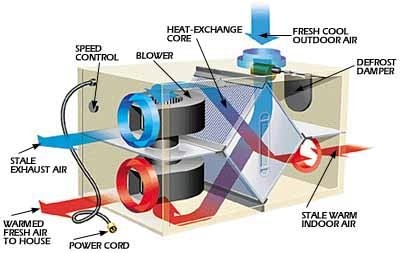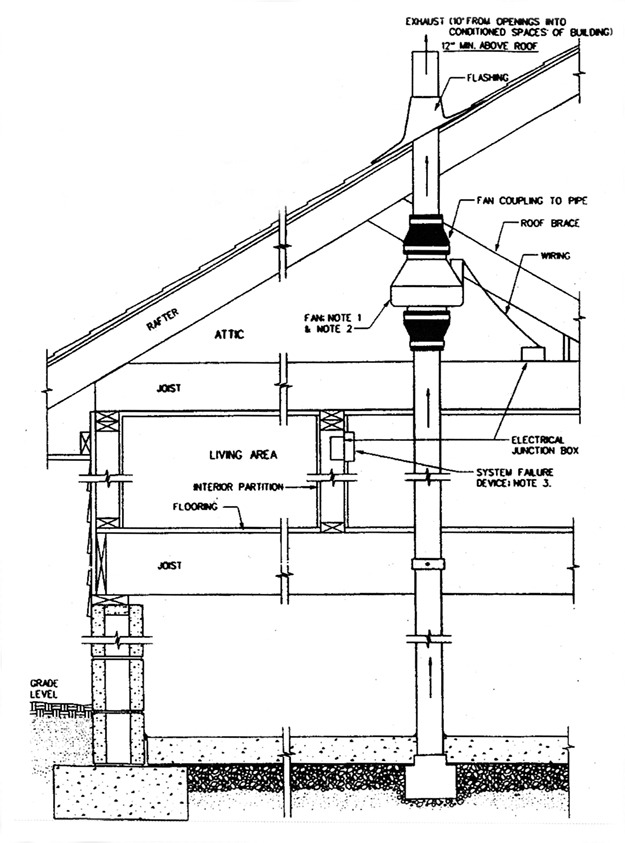Specializing in low cost and energy efficient designs
Our radon mitigation techniques are customized to meet the environmental, aesthetic and cost needs of each homeowner. We specialize in hidden mitigation systems typically routed through an attached garage or through the house itself. This can limit the system’s visibility to just 12 inches of exhaust (as pictured below). We also offer cost effective strategies to meet the homeowners needs, which are typically routed externally on the back of the home.
Sub-Slab Depressurization
The method most commonly used is a sub-slab depressurization system (above) which typically consists of a vent pipe system and fan that pulls radon from beneath the house and vents it to the outside. Generally indoor radon can be mitigated by sub-slab depressurization and exhausting such radon-laden air to the outdoors, away from windows and other building openings.
Sub-slab suction prevents radon from entering your home by drawing the radon from below the home and venting it through a pipe, or pipes, to the air above the home where it is quickly diluted. The “EPA does not recommend the use of sealing alone to reduce radon because, by itself, sealing has not been shown to lower radon levels significantly or consistently” according to the EPA’s Consumer’s Guide to Radon Reduction: How to fix your home.
Modern energy-efficient construction that conserves energy by making homes airtight often exacerbates the risk of radon exposure. Less tightly constructed homes with greater air leaks are often just as likely to present elevated risks.
Sub-slab depressurization techniques are also frequently used to mitigate VOC vapor intrusion problems due to toxic contaminates in the soil and/or the groundwater.
Heat Recovery Ventilator
Ventilation systems can be utilized to purify the air in you’re home and lower you’re radon levels, particularly in older homes where sub-slab depressurization may not be feasible. A heat exchanger or energy recovery ventilator can be used to recover part of the energy otherwise lost in the process of exchanging air with the outside.
Sub-Membrane Depressurization
For crawlspaces, we follow EPA guidelines, which state, “An effective method to reduce radon levels in crawlspace homes involves covering the earth floor with a high-density plastic sheet. A vent pipe and fan are used to draw the radon from under the sheet and vent it to the outdoors. This form of soil suction is called sub-membrane suction, and when properly applied is the most effective way to reduce radon levels in crawlspace homes.”
The Mitigation Process (Sub-Slab Depressurization Summary)
- One of our radon mitigation specialists will inspect your home and draw up a detailed sketch to review the mitigation process step by step with you.
- Once the appropriate suction point has been chosen we will begin diagnostics. This is done to make sure pressure field extension is achieved. Suction is applied to the chosen suction location while a state of the art manometer (pressure gauge) is placed on the opposite side of the basement to ensure desired negative pressure extension. This is also done to ensure proper fan and pipe sizing for each system.
- If the appropriate pressure field extension is achieved the suction site will then be cored.
- Aggregate and or soil will then be removed from below the suction point (about 5 gallons). Some systems can also tap directly into the drain tile.
- All sub-slab open air sources will be appropriately sealed and/or modified to ensure a proper seal. This includes the sump pump, cold seams/joints, foundation cracks, block cores, french drains, and daylight discharges.
- System is the installed using 3 or 4 inch schedule 40 PVC along the desired route, using fire collars and pipe insulation when necessary.
- System Fan is installed and exhausted accordingly.
- System monitors and labels are placed.
- After instillation the system will need to run for 24 hours before the post mitigation radon test can be conducted. This test will take 48 hours.




